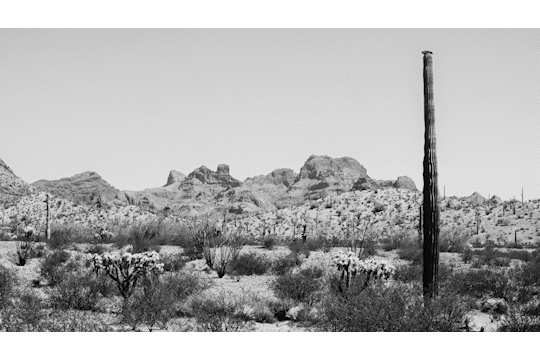Orientation: Montañas en el Desierto
Orientation: Montañas en el Desierto highlights five mountains in the ancestral lands of the Hohokam, Tohono O’odham, and Hia C-ed O’odham.
The arrival of European settlers in the 1700s brought a long period of violent transformation to the lives of the people, flora, and fauna that have called this desert and waterways home since time immemorial. In the last century or so –long after the establishment of the United States and its colonial borders– these mountains have been used as landmarks along routes utilized by people traveling north across the so-called Arizona-Sonora border. They have been given names or ‘sobrenombres’ with the hope of finding orientation and guidance along their journey.
Names and labels are a projection of human ideology and value-systems, but they are not of the land. Names given to mountains, water sources, and paths can be based in sacred relationship and oneness with the land as exemplified by Indigenous People throughout the world caring for and honoring Mother Earth. The colonial names given by European colonizers and U.S. Imperialists, on the other hand, are rooted in genocidal erasure, ownership, and exploitation.
It is vital for us to reorient ourselves towards a world that centers the Indigenous People whose lands we are on. Understanding the complex context of the names of these five mountains can serve as an example of how naming and map-making can tell stories of what the land has experienced and witnessed.
I approached this project with humility and care as someone who has had the privilege of engaging in migrant solidarity work along these lands as a non-O’odham person with ancestral roots south of the so-called US-Mexico border. My relationship with these lands began with my grandfather, who crossed the border through this region. This project was a way for me to connect with the land in and outside of the context of migration and border militarization.
It was essential for me to ground this project in my relationship with land. To me, this meant spending time with the mountains and their homes. I created ink portraits during visits to each mountain where I observed, witnessed, and gathered items with immense intention and care. Prior to initiating each sketch, I rooted myself and prayed to the land –asking for forgiveness, permission, and a return to a balanced world. Each mountain portrait is documented through process videos that can be found on each mountain’s page. I then created block prints inspired by the “sobrenombres” given to each mountain by people in migration. “Sobrenombre” in English directly translates to “name on top of”.
The act of labeling land, and in this case naming mountains, is one that can be as much about erasure as it can be about resilience and reciprocity. The desert is a beautiful sacred space and I dream and pray for a world that treats these lands and all life as such.
LA MUELA
(32.11560, -112.95610)
EL BUDA
(32.11491, -112.70613)
LA AGUJA
(32.40444, -113.12247)
LA FAMILIA
(32.32505, -112.87015)
LA BALLENA
(32.48191, -112.62197)
SOURCE:
O’odham Indigenous Names: https://www.joannecouttsmaps.com/maps.html







